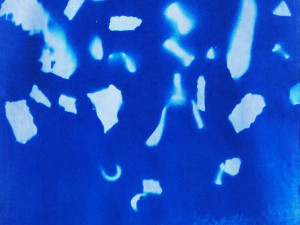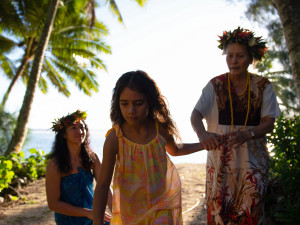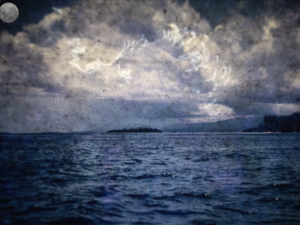Oceanic Visions / Moana te kite
–
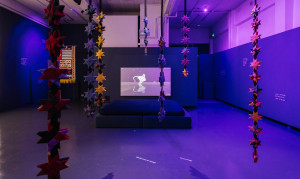
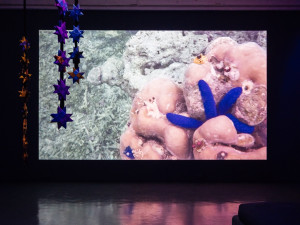
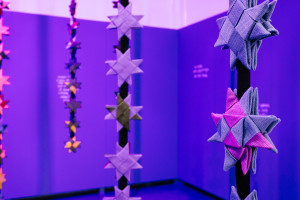
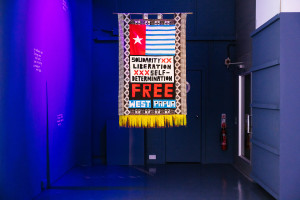
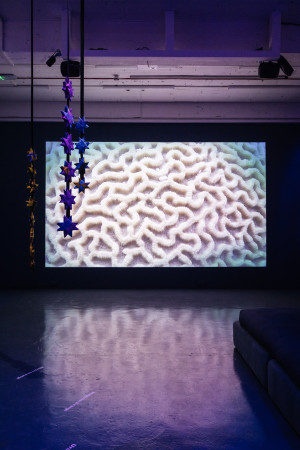
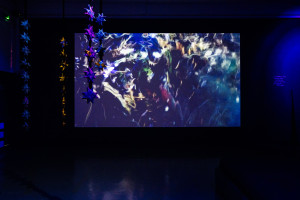
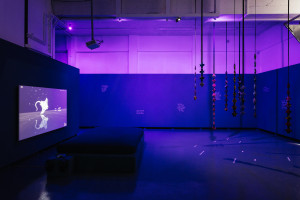
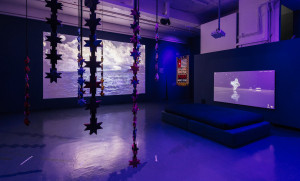
Preview: Thursday 24 April, 6.30–8.30pm
All welcome!
During this event we are hosting a panel discussion in the studio - learn more
The exhibition Oceanic Visions /Moana te kite centres around the Pacific Ocean, the largest body of water covering approximately 63 million square miles and containing more than half of the free water on Earth.
Exploring multiple island perspectives, cosmologies and concerns, through the lens of the region’s wealth of cultural, environmental and geopolitical diversity, the gallery space hosts knowledge-sharing, immersive visual experiences and learning activities about the Pacific.
Premiering in London, the film Hyena Lullaby (2020) by Taloi Havini and Michael Toisuta, commissioned by TBA21–Academy, with the support of Institut Kunst HGK FHNW in Basel, explores the underwater phenomenon of coral decline and self-regeneration through spontaneous mass spawnings at night, which the Nakas people call ‘Hyena’.
Havini and Toisuta’s film is presented alongside Digital Ocean, an interactive digital project by the Mana Moana collective led by Rachael Rakena (Ngāi Tahu, Ngā Puhi, Ngāti Pākehā), Mike Bridgman (Tonga, Ngāti Pākeha) and Dr Karlo Mila (Tongan / Pākehā). The Digital Ocean project brings together the work of more than 20 leading Māori and Pacifika artists.
Interisland Collective, a queer-led collective of tagata Moana (Pacifika, Oceanic people) artists, creatives, and activists have created an artwork with members of the UK’s Pacific diaspora. The installation – Matariki – is made up of 9 strings of suspended whetu (stars). Each string of whetu represents a specific star in Te Kāhui o Matariki known in the West as the Pleiades cluster. Matariki is celebrated all over the Pacific. In Aotearoa, it is a time to come together to remember all those that have passed into the realm of the star Pōhutukawa in the previous year and to celebrate the coming of the New Year by giving thanks for the gifts of our Taiao (natural world) to Waitī, star of freshwater bodies and all foods they contain; Waitā, star of the Moana (ocean) and the food it provides; Waipuna-ā-rangi, star of rainfall; Tupu-ā-nuku,star of all that grows in the earth and is harvested; Tupu-ā-Rangi, star of fruits, berries birds and all that grows on trees; Ururangi, star of the winds; Hiwa-i-te-Rangi, the wishing star and Matariki, star of people’s health and well being.
‘Each star in this installation is hand woven in polycotton ribbon and is a taonga (treasure) created with aroha (love) by the coming together of friends old and new, the sharing of knowledge, the sharing of kai (food), laughter and the delight of being in each other’s company so far from our beloved Te Moananui-a- kiwa (Pacific Ocean).’
Painter, printmaker, writer, and poet John Pule (Niuean) has created a new series of poems – Kavaka – rooted in Oceania/Moana nui a Kiwa/Pacific. Many of these poems were written during the artist’s travels in Fiji, Rotuma, Raoul, Rapa Nui, Tonga, Aotearoa, the Solomons, Hawai’i, Niue and other nations in the Pacific. Like waves of words, the poems rise and fall throughout the exhibition and convey Pule’s attempts to ‘decolonise his mind’ with intimate reflections on family, Niuean mythology and cosmology, migration, and missionarism. A limited edition book of the poems is available to take away.
Momoe i manu ae ala atae’e Tasker (Sāmoan / Chinese / British), an ‘afakasi agitator’ born in Taitoko (Levin) Aotearoa (New Zealand) and raised in London, whose work ‘investigates the marginalisation of women of colour, feminism, abuse, decolonisation and cultural identity’ has created a protest banner in kinship with the West Papuans. Momoe writes, ‘As tangata moana, tangata whenua and peoples of the Pacific, we raise the Morning Star flag in solidarity with our West Papuan family fighting for their right to self-determination’.
The works, activations and screening programme form a chorus of Pacific artists, poets, and community leaders expressing land sovereignty, knowledge sharing, and care for the ocean’s well-being.
Alongside the exhibition, we will present a programme of historical and contemporary films by Indigenous filmmakers navigating the region’s interconnected knowledge systems and political struggles. More information will be available soon.
About the artists
Taloi Havini (Nakas Tribe, Hakö people) was born in Arawa, Autonomous Region of Bougainville and is currently based in Brisbane, Australia. She employs a research practice informed by matrilineal ties to her land and communities in Bougainville. Her works encompass various media, including photography, audio–video, sculpture, immersive installation and print. She curates and collaborates across multi-art platforms using archives, working with communities and developing commissions locally and internationally. Knowledge production, transmission, inheritance, mapping, and representation are central themes in Havini’s work in relation to land, architecture, and place.
Michael Toisuta grew up in Central Java, Indonesia. Since moving to Australia, he has worked as a composer and sound designer for theatre, dance, film and video art installations. He has sound-designed video art installations Habitat 2018 (Asia Pacific Triennial 2018) and Habitat (The National 2017), as well as short films Woodlands (Barcelona International Film Festival), Jyoti (Short Film Corner at Cannes Film Festival), Dance Diaries (Parramasala 2018) and Double Landscape (Bundanon Trust Siteworks 2016).
Interis*land Collective is a queer-led collective of tagata Moana (Pasfika, Oceanic people) artists, creatives, and activists based in London, MOKU Pacific HQ - a space to create and connect, with a focus on art, film, and activism, while also advocating for West Papua’s right to self-determination.
Mana Moana collective
Mana Moana is a curated artist-led collaboration between Māori and Pasifika visual artists, musicians, writers and choreographers.
Rachael Rakena (Ngāi Tahu, Ngā Puhi, Ngāti Pākehā) coined the term ‘Toi Rerehiko’ to describe and locate her own video/ digital/ electronic-based art practice in terms of continuum, motion, and collaboration. Critiquing notions of fluid identity and cultural understandings of space and water through metaphors of digital space as water space, inhabited by iwi Māori, her art installations have evolved to enculturate and politicise water, navigating issues of ongoing Pacific diaspora, flooding and rising sea levels, and decolonisation/(re) vitalisation. Exhibiting internationally for 20 years and lecturing for 25 years, she is currently based at Whiti o Rehua School of Art, Massey University. Aotearoa.
Mike Bridgman (Tonga, Ngāti Pākeha) is a multidisciplinary digital artist who has been working within the digital realm for over twenty years across many different industries, including film, theatre, television, print, web, video games, music videos, public installations, festivals, fashion shows, museums, experiential live shows, interactive performances and projection mapping.
Dr Karlo Mila is an award-winning poet, writer, mother, activist and researcher. She is the author of three poetry books, including Dream Fish Floating (2005), which won the Jessie MacKay Best First Book of Poetry at the 2006 Montana New Zealand Book Awards. Her most recent book, Goddess Muscle, was released by Huia Publishers in 2020. She is of Tongan and Pākehā descent, with ancestral connections to Sāmoa. Born and raised in Aotearoa, New Zealand, her poetry and professional career have focused on the realities of Pasifika identity, love, life and the politics of relationships. In 2019, Karlo was awarded an MNZM for services to the Pacific community and as a Poet. She was the winner of the CNZ Contemporary Pacific Artist Award in 2016.
A performance poet and artist, John Pule, ONZM, is largely self-taught and leads a double career as a visual artist and writer. Born in the village of Liku on the small South Pacific island of Niue, his family moved to New Zealand in 1964. Growing up in Auckland, Pule, one of the Pacific’s most significant artists, has been widely celebrated at the forefront of New Zealand contemporary art since the 1990s. Continually returning to Niue as an adult, Pule finds inspiration in his home country’s history, spirituality, and migration experience. His works depict the natural world in a lyrical embrace with humans as a personal approach to world-building. Through his visual and literary works, Pule deliberately amplifies the voice of Pacific cultures and the history of colonisation and migration.
